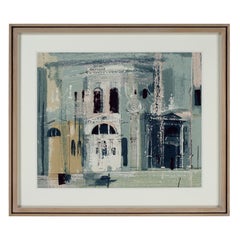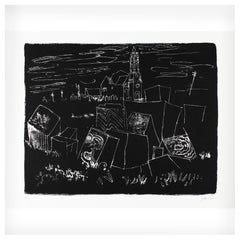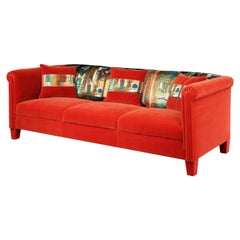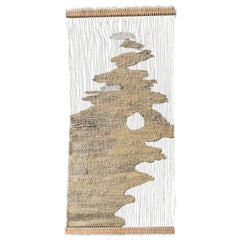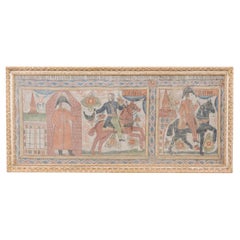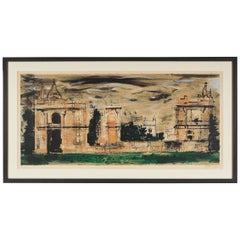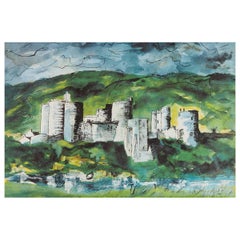John Piper Furniture
4
to
3
1
4
4
4
3
1
4
4
2
1
2
1
1
1
1
4
4
2
13
5,206
4,014
2,455
2,235
Creator: John Piper
John Piper London Skyline Coffee Table by Myer for Conran and Heal’s, c. 1960
By Sir Terence Conran, Myers, John Piper, Heal's
Located in San Francisco, CA
A very charming circa 1960 two-tier low coffee table featuring an illustrated London skyline top by John Piper, and produced by Myer for Conran and Heal’s.
White formica top serves ...
Category
1950s British Mid-Century Modern Vintage John Piper Furniture
Materials
Metal
John Piper Chiesa Della Salute Venice Screenprint Textile 1959 Sanderson
By John Piper
Located in BUNGAY, SUFFOLK
JOHN PIPER CH (BRITISH,1903-1992) :CHIESA DELLA SALUTE, VENICE Screenprinted fabric, printed by Sandersons, 1959
In the late 1950's to the early 60's there was interest in painterly textiles that demonstrated the unique potential of screen printing, with its ability to capture the quality of brush-stroked colour
"The monumental grandeur of many artists' textiles in the early 1960's was necessary if they were to work in the large scale architectural interiors of the era which witnessed a rapid growth in new public buildings, all which required furnishing with suitably prestigious fabrics".
The painterly design is one of five fabrics designed by John Piper (1902-1993) for A Century of Sanderson 1860-1960, Sanderson's prestigious Centenary Collection.
This study of the Chiesa della Salute church in Venice was taken from Piper's 1959 travels when he was commissioned by the Arthur Jeffress Gallery in London. He then regularly made paintings of the city, and drew illustrations for an edition of Adrian Stokes...
Category
1950s English Mid-Century Modern Vintage John Piper Furniture
Materials
Textile
John Piper Easton Portland Dorset St George Reforne lithograph 2/70 1964
By John Piper
Located in BUNGAY, SUFFOLK
JOHN PIPER CH (BRITISH,1903-1992) : 16. EASTON, PORTLAND, DORSET: ST GEORGE REFORNE, AN 18TH CENTURY CHURCH AMONG THE QUARRIES, NUMBERED 2/70 LOWER...
Category
1960s English Mid-Century Modern Vintage John Piper Furniture
Materials
Paper
Settee, 1950, French, 3-Seat, Upholstered, Red, Velvet, John Piper
By John Piper
Located in BUNGAY, SUFFOLK
Incorporating 'Stones of Bath' into this settee is inspired the pipers use of one of the five designs commissioned for their centenary, ‘The Glyders’, as loose covers for the chairs at their home Fawley bottom which John Betjeman called ‘Fawley Bum’.
'Stones of Bath' is one of five John Piper (1903-1992) designs commissioned by Arthur Sanderson & Sons in 1959 for their 1960 centenary celebrations. In 1962 Sanderson's screen printed ‘Stones of Bath’ on their Sanderlin fabric, a satinised linen which gave the design a shimmering, restless texture. This was ideally suited to the play of light depicted on the stone in the architectural repeat of buildings in the city of Bath.
A piece of this fabric which is in the collection of the V&A was exhibited at the John Piper retrospective held at the Tate Gallery, London, 1983. Reference: 'Artists’ Textiles in Britain 1945-1970', Cat. No. 74.
From the late 1950s-early 1960s there was interest in painterly textiles that demonstrated the unique potential of screen printing, with its ability to capture the quality of brush-stroked color. 'The monumental grandeur of many artists' textiles in the early 1960s was necessary if they were to work in the large scale architectural interiors of the era which witnessed a rapid growth in new public buildings, all which required furnishing with suitably prestigious fabrics'. Artists' Textiles in Britain 1945-1970 by Geoffrey Rayner, Richard Chamberlain...
Category
Mid-20th Century British Modern John Piper Furniture
Materials
Velvet
Related Items
2 Tapistries by Simone Prouve
By Simone Prouvé
Located in Long Island City, NY
Cotton, wool and mix-media. Both signed.
Simone Prouve (born 1931) is the daughter Jean Prouve.
Dimensions: H 93’´x W 62’´ and H 93’´x W43" for the rope ...
Category
1970s French Mid-Century Modern Vintage John Piper Furniture
Materials
Wool, Cotton, Rope
19th C. Swedish Textile Set in Egg-n-Dart Carved Wood Frame
Located in Atlanta, GA
A decorative art piece featuring 19th century Swedish fabric set behind glass in a carved-wood frame. This 19th century fabric from Sweden, primiti...
Category
19th Century Swedish Antique John Piper Furniture
Materials
Fabric, Glass, Wood
French Settee in Red Velvet Upholstery
Located in Waalwijk, NL
Settee, velvet fabric, stained beech, France, 1930s
This exquisite settee of France origin adopts stylistic motifs of the 19th century Victorian Era as can been seen in the ornate ...
Category
1930s French Art Deco Vintage John Piper Furniture
Materials
Velvet, Beech
French Giltwood Settee Sofa, Style Louis XVI, Red Velvet, 19th Century
Located in Montreal, Quebec
French giltwood settee sofa, style Louis XVI, red velvet, 19th century.
Dimensions: 53.5 in. L 25 in. D x 39.5 in. H
Seat height 20 in.
Category
19th Century French Louis XVI Antique John Piper Furniture
Materials
Velvet, Wood
Italian Mohair Settee Sofa, Brown, 1950s
Located in New York, NY
Beautiful mohair upholstered curved sofa with wooden legs. Perfect shape and size.
In excellent condition, 1950s, Italy.
Category
Late 20th Century Italian Mid-Century Modern John Piper Furniture
Materials
Mohair, Wood
Two Framed Pre-Columbian Textile Fragment Chancay Culture Peru
Located in Atlanta, GA
Two framed pre-Columbian textile fragments from Chancay culture (1000AD-1470AD) in nowadays Peru. Both panels are of a similar red background and possibly wove...
Category
15th Century and Earlier Peruvian Pre-Columbian Antique John Piper Furniture
Materials
Wood, Textile
French Baroque Style Velvet Upholstered Knole Style Settee, 2nd half 20th cen.
Located in Atlanta, GA
Upholstered in green velvet with applied embroidered tape/trim with matching braid and fringe, adjustable padded wings controlled by roping.
The original Knole Settee (also known as the Knole Sofa) is a couch chair that was made in the 17th century, probably around 1640.[1] It is housed at Knole in Kent, a house owned by the Sackville-West family since 1605 but now in the care of the National Trust.[2]
It was originally used not as a comfortable sofa but as a formal throne on which the monarch would have sat to receive visitors. It was wide enough that a monarch and consort could be seated side by side. As of 2021, it is kept at Knole House...
Category
Mid-20th Century French Baroque John Piper Furniture
Materials
Velvet
H 41 in W 81 in D 33 in
Original Marked Elie Grekoff Cotton & Wool Textile Tapestry France 1950
By Elie Grekoff
Located in Miami, FL
Elie Grekoff printed Cotton and Wool Tapestry and signed, figured zodiac symbol LIBRA.
Made in France, circa 1950 Mid-Century Modern Era.
Category
1950s French Mid-Century Modern Vintage John Piper Furniture
Materials
Wool, Cotton
19th Century English Regency Style Upholstered Mahogany Sofa Settee
Located in Rio Vista, CA
Distinctive late 19th century upholstered mahogany sofa or settee made in the English Regency taste. Beautifully crafted with an older restoration featuring a tall square back mahoga...
Category
19th Century English Regency Antique John Piper Furniture
Materials
Brass
Mid Century Walnut 2 tier coffee table Ewart Myer for Horatio Myer and Co, 1960s
Located in Leamington Spa, GB
A 1950/60’s ‘Ski’ form coffee table by Ewart Myer for Horatio Myer and Co
Two tier with a sleigh walnut bentwood top and magazine rack shelf to the bottom.
Ewart designs a rather unique coffee table.
Taking inspiration during the height of the mid-century modern craze in 1955, he designs a Danish inspired bent plywood piece, aptly named - the ‘Ski’ Table...
Category
Mid-20th Century British Scandinavian Modern John Piper Furniture
Materials
Beech, Walnut
H 14.97 in W 43.9 in D 14.97 in
1960s Teak Coffee Table by Clausen and Son for Silkeborg, Denmark
By Clausen & Søn, CFC Silkeborg
Located in Praha, CZ
- Carefully refurbished
Category
1960s Danish Mid-Century Modern Vintage John Piper Furniture
Materials
Palisander
Marble Oak Table By Heals of London and Adam Daghorn Limited Edition
By Heal's
Located in Belfast, Northern Ireland
Heal’s (or sometimes referred to as just Heals) of London Oak and Marble Dining Table is a limited edition Heal's collaboration from 2018 with designer Adam Daghorn. Blake is a caref...
Category
2010s British Mid-Century Modern John Piper Furniture
Materials
Carrara Marble
H 29.53 in W 70.87 in D 35.44 in
Previously Available Items
John Piper Lithograph
By John Piper
Located in Petworth, West Sussex
John Piper (British, 1903-1992), "Moreton Corbet", color lithograph, circa 1967, signed, numbered 31/70, size: ca 45 x 100cm.
Category
Mid-20th Century John Piper Furniture
Materials
Other
John Piper 'Kidwelly Castle' Lithograph
By John Piper
Located in Petworth, West Sussex
John Piper (British, 1903-1992), 'Kidwelly Castle', color lithograph on wove paper, printed in 1984 by Senecio Press, from an edition of 20 prints supplied with the book ‘Deaths and ...
Category
1980s British Vintage John Piper Furniture
Materials
Paper
John Piper, Tetbury, Ink, Watercolor, Gouache, Pastel, 20th Century, Abstract
By John Piper
Located in BUNGAY, SUFFOLK
John Piper, Tetbury, ink, watercolour, gouache, pastel, 20th century, abstract
John Piper (British,1903-1992): Tetbury
Signed 'John Piper' (lower right)
Ink, watercolour, gou...
Category
1950s Vintage John Piper Furniture
Materials
Paper
H 22.45 in W 29.93 in D 1.19 in
Coffee Table, Sofa Table, John Piper, London Skyline, Myer, Heals, Conran
By John Piper
Located in BUNGAY, SUFFOLK
The main feature of this highly decorative low sofa/coffee table is the London Skyline picture by John Piper, one of the leading artists in the UK abstract painting movement inspired by the work of Paris-based painters. Few pieces of furniture incorporate fine art and achieve a high aesthetic which give this table gravitas. This is combined with practicality as the narrow, long scale of this table is fit for purpose and as are the laminated top and the shelf.
The formica top features a color composition by John Piper of St. Paul's, St Martin in the Fields and Lincoln's Inn, London. The powder coated, black metal frame is fitted with a black wooden shelf...
Category
Mid-20th Century British Mid-Century Modern John Piper Furniture
Materials
Formica
H 13.78 in W 44.89 in D 14.97 in
John Piper, Abstract, Landscape, Tetbury, 1957, Watercolor, Gouache, Pastel
By John Piper
Located in BUNGAY, SUFFOLK
ARTIST : JOHN PIPER (British,1903-1992)
Tetbury
Signed 'John Piper' (lower right)
Ink, watercolor, gouache and pastel
Executed in 1957
PROVENANCE : Save & Prosper collection, ...
Category
1950s Modern Vintage John Piper Furniture
Materials
Paper
H 30.71 in W 37.8 in D 0.04 in
John Piper, Rock-Face, Modern British, Oil on Panel, 20th Century, Abstract
By John Piper
Located in BUNGAY, SUFFOLK
John Piper, Rock-Face, modern British, oil on panel, 20th century, abstract
John Piper (British,1903-1992) : Rock-face
Signed 'John Piper' (lower right)
Signed and inscribed with title (verso)
Oil on panel
Executed in 1950 according to Buchholz Gallery label verso
Provenance: Buchholz Gallery (Curt Valentin), New York
Exhibited: Bucholz Gallery (Curt Valentin), John Piper, Recent Work, October 17th–4th
November, 1950, Cat. no. 10
Related to: In the monograph on Piper by John Woods, the picture most like it is a larger oil, Rock Face, Cwm Tryfan 1950, plate 121, collection of Museum of Modern Art, New York. Rock-face is probably an observation at Tryan also.
Reference: John Piper : Special Exhibition, Blenheim Palace until 9th April. The Mountains of Wales, National Museum Cardiff, until 9th May
Height 15.8 cm., 6 ¼ in., Length 20 ½ cm., 8 in.,
In a color washed, bevelled frame
Frame Height 35 cm., 13 ¾ in., Length 40 cm., 15 ¾ in.
John Piper is famous for architecturally detailed pictures of houses, churches and ruins. As S. John Woods writes in John Piper: Painting, Drawings and Theatre Designs 1932-1954 (London: Faber & Faber, 1954) 'his approach was that he wanted to paint a house as if he were designing it, understanding not just its appearance but its anatomy and its sentiment’. John Carter wrote in an exhibition catalogue, that Piper, is 'acutely aware of the bones of a building.'' This approach Piper also brought to his landscape paintings, and it is clear in the present work. A sense of painting while keeping at the front of the mind the inner structure of the stone in front of him; its age and architecture. There is the sense of the boulder as the result of someone's intention, as an object of a Creation.
In British Romantic Artists (London: William COX, 1942) John Piper wrote: 'Romantic art is the result of a vision that can see in things something significant beyond ordinary significance: something that for a moment seems to contain the whole world; and, when the moment is past, carries over some comment on life or experience beside the comment on appearances.'
In 1950 John Piper was well into his post-war period which was characterised by techniques such as the scratching in the oil paint apparent in the present work, a more sombre palette generally, and a concentration on landscape and natural features, particularly those of Portland in Dorset, where his fascination for geology in a form which has been changed by man could have full rein in the quarry; and also, extensively, those of North Wales, which he had been visiting since a commission in 1943 to paint the underground quarry in which the Nation Gallery's collection of art was being stored for the duration of the war. He returned for periods of the winter over the next seven or eight years, for part of that time, including in 1949-50, renting a cottage at Bodesi, below the Tryfan Mountain.
Boulder fields at Bodesi, Bodesi Farmhouse, 2011
Here there was much inspiration: in the extreme geology of the land, and in the effect of winter light on mountains. Piper was inspired by the IDEA of the sublime, and the eighteenth century landscape work of Richard Wilson, and spent time trying to locate Wilson's viewpoints.
Richard Wilson, Llyn-y-Cau, Cader Idris, 1774
Cited in John Piper: Painting, Drawings and Theatre Designs 1932-1954 (London: Faber & Faber, 1954), Piper is quoted as saying: 'In paintings of North Wales, as of many mountain areas, a rock in the foreground often shows the same form and, in its fractures and the way it lies, the same direction as the whole mountain range in the distance'.
Boulder at Cwm Tryfan
In the same book, S John Woods writes: 'the near abstract paintings he did about 1950, based on rocks and walls, are among his best works'.
Writing in The Listener on March 29 1933, (the article entitled Younger English Painters II) Piper quotes DH Lawrence writing in 1915: ''One can only build great abstraction out of concrete units... The architecture comes in painting only with the suggestion of some whole, some conception which conveys in its own manner the whole universe. Most puerile is this clabbing of geometric shapes behind one another, just to prove that the artist is being abstract, that he is not attempting the representation of the object. The way to express the abstract whole is to reduce the object to a unit, a term, and then out of these units and terms to make a whole statement''.
Piper's landscapes and works with a natural subject are knowingly situated in the traditions of landscape painting reaching back to the seventeenth century. In the seventeenth century landscape painting was an expression of religion - the veneration of that which is made by the hand of God. In the eighteenth century, the century of Enlightenment, it became an expression of the Cult of Nature - venerating the rules and laws which were being derived and discovered in the natural world. Piper's approach, of spending long periods of time in order to understand and express the intrinsic nature of the rock in front of him is very much a development of this long tradition, and a clear in the present work. As Woods wrote: 'These (paintings of North Wales) are not dramatised, but their greys and browns and black are rich with the sense of place and climate'.
John Piper, a note written near the Summit of the Glyders, Snowdonia: ' Mist blowing across all day: visability about 15 - 20 yards only, curious sensation in presence of gigantic boulders, giant coffin slabs, pale trunk-shaped rocks, disappearing into grey invisibility even at close range. The affectionate nature of the mountain not changed by the acute loneliness and closed-in feeling induced by the mist'.
‘ I felt then that I was seeing the mountains for the first time and seeing them as nobody had seen them before. This was due partly to the feeling of release after the confining of the war, partly to a “spurt” in my capacity to observe more clearly at this particular time. Each rock lying in the grass, had a positive personality: for the first time I saw the bones and structure and the lie of the mountains, living with them and climbing them as I was, lying on them in the sun and getting soaked with rain in their cloud cover and enclosed in their improbable, private rock-world in fog.’ Pipers Places, p105.
Rock-face was painted in 1949-50 when Piper was renting Bodesi farmhouse and is most likely that it is an observation of rocks at Tryfan which is nearby. In Rock Face, the rock has become metaphorical and, of an extraordinary grandeur, both observed and painted in abstract form. ‘ In his search to find the exact color of the rocks Piper imaged them to be animals feeling the shades of the weather, “ sometimes antagonistic ” as “ they react “. The paradigm of his drawings of Snowdonia was often the relation between a prostrate foreground and a distant background Summit, one pinkish and one bluish. The shapes are intricate and crafted, yet on a scale beyond human, apparently the realm of the “ enormous and untidy race of men ‘. He was surely contemplating mortality. ‘ David Fraser Jenkins
The coloring in Rock Face is bold and intense, typical of the oils executed in 1950, illustrating Piper as a brilliant colorist. ‘ The rocks can only look grey in leaden light, and then do not, commonly. Against mountain grass or scree, against peaty patches near tarns, on convex slopes, in dark cwms, the same kind of rock can look utterly different, and changes equally violently in color according to the light and time of year. ‘ JP. ‘ Lake frozen, from west end under the crags reflecting the sky – palest blue Zenith, fading downwards through orange and pinkish orange to translucent grey in reverse. White frosty rock surfaces contrasting violently with dark and shadowed ones.’ Diary entry 17th January 1946
Whether Piper intended to use the metaphor of the rock-face as a device to show human mortality or to show the effect of the weather on the rock-face is debatable. It is true that there is a small group of abstracted oils executed at this time and Rock-face appears to be the most abstracted version.
Glyders Rocks, 1950, Oil, 20x29, SJ Woods, no 120.
Rock Face, Capel Curig, oil 28x36, 1950, SJ Woods, no 119.
Figurative work appears in Piper’s stained glass designs. Foliate or ‘leafy’ heads are perhaps one of Piper’s most distinctive motifs, appearing in his works in a variety of media including tapestries and ceramics as well as drawings, paintings and prints. Their form is based loosely on traditional ‘green men’, found in the architecture of many medieval and nineteenth-century buildings. The recurrence of the image perhaps reflects Piper’s fascination with detailed medieval church carvings...
Category
1950s European Modern Vintage John Piper Furniture
Materials
Oak
H 6.23 in W 8.08 in D 0.08 in
John Piper furniture for sale on 1stDibs.
John Piper furniture are available for sale on 1stDibs. These distinctive items are frequently made of paper and are designed with extraordinary care. There are many options to choose from in our collection of John Piper furniture, although black editions of this piece are particularly popular. Many of the original furniture by John Piper were created in the modern style in europe during the mid-20th century. If you’re looking for additional options, many customers also consider furniture by William Ernst Burwell, Joe Tilson, and Christie's. Prices for John Piper furniture can differ depending upon size, time period and other attributes — on 1stDibs, these items begin at $6,421 and can go as high as $57,787, while a piece like these, on average, fetch $28,894.
